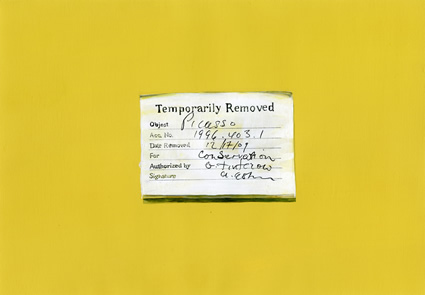Jelly donuts, and the color of bile: 3 questions for Jen Mazza

Jen's the artist whose "yellow" works we ran a few weeks back - which works, it turns out, we were wrong about. Details follow.
***
You're perhaps best known for your paintings that depict, in detail, the effects of violence on the body. Counterintuitively, you've been quoted as saying that you find these works "kind of funny"...
Though you are not alone in your reading of the works, I generally don't associate my earlier figurative works with violence, beyond the everyday violence of being. I think of them as external manifestations of internal states - usually complex experiences of emotions or of sensing ones own mortality or humanity. The series often referred to as funny is case in point: the title Schadenfreude means taking pleasure at other's misfortune. The paintings depict a jelly doughnut being squeezed and mashed between two hands. Though there is an obvious bodily reference in the red jam, the series seems rather irreverent.
Is there a side we're not seeing, to the works we're featuring? On their face, they're light, both in subject - flowers, wallpaper - and in your treatment, which relies on a sunny, saturated yellow, used in a way that seems to say "relax." But, as with your beaten-body work, is there another way to look at them?
Have you ever read "The Yellow Wallpaper"? I think there is something rather subversive about painting flowers, and, well sunflowers are yellow, but so is bile... I am reminded of a quote from Sherlock Holmes: Country houses "always fill me with a certain horror. It is my belief, ... that the lowest and vilest alleys in London do not present a more dreadful record of sin than does the smiling and beautiful countryside."
The bold use of a single color is central to much of your best work - including the body paintings and the drawings shown on your site. Your "entr'actes" as well, which strike us as all about the rich black background. Each set seems as though it could have been created from the urge to see what you could do with a color - red, in the former case, and white in the latter. Did the color determine the subject, and your approach to it, in any of these instances? Or did your subjects suggest - perhaps even demand - the colors you chose to depict them?
I suppose you are right, the series do seem to link up based on color relationships. It is not always planned. In many of the figurative paintings, such as in the Scarlet Intent series, the red is a way into the flesh, an exposure of what is under the skin, the way flushed skin might betray a secret, a shame, or a desire. The "Yellow Drawings" came about from a visceral craving for that particular mustardy color, which is not without its own connotations. The white and black of the gloves in Nuit Blanche and the Entr'actes are a study in contrasts. The paintings and drawings are nearly monochromatic except for the place where the wrist parts the skin of the gloves. The flesh then reads like a wound pierced through the white.

